 Indians Archive
Indians Archive  Tribe Game Vault: 06/29/1984. Mike Hargrove (the Player) Has a Chance to Be a Hero
Tribe Game Vault: 06/29/1984. Mike Hargrove (the Player) Has a Chance to Be a Hero
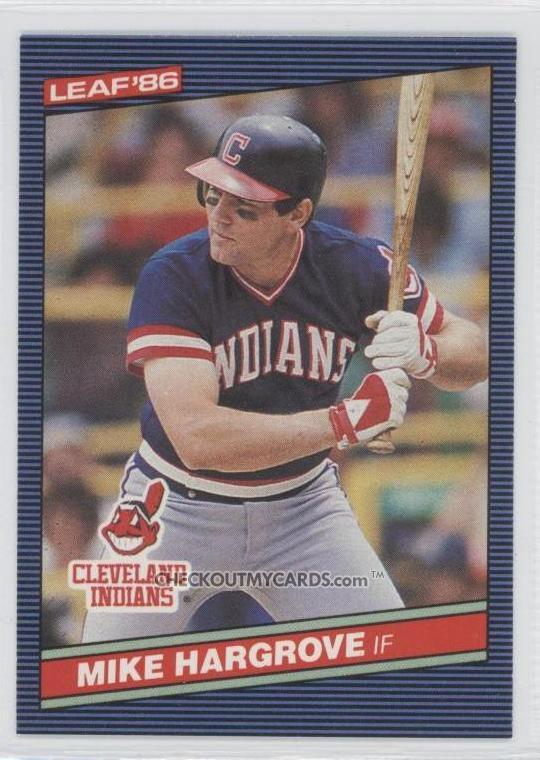 I attended a Single A Dayton Dragons game one Sunday afternoon back in August of 2001. My brother-in-law and I made a day of it with my daughter and nephew, who were 10 and 11 years old at the time. The Dragons were (and are) a tough ticket; the only ‘seats’ available was the grassy hill behind the right field fence.
I attended a Single A Dayton Dragons game one Sunday afternoon back in August of 2001. My brother-in-law and I made a day of it with my daughter and nephew, who were 10 and 11 years old at the time. The Dragons were (and are) a tough ticket; the only ‘seats’ available was the grassy hill behind the right field fence.
The kids weren’t really into baseball. I, on the other hand, was prit-tie knowledgable. Yep, you betcha. I was determined to make the day memorable for them. As we sat on a blanket on the hill among local little league teams and young families, we discussed the Dragons’ opponent. They were from Quad City. (“Do you know where that is?”) I described the action. I pointed out the hole on the right side of the infield as the first baseman held a runner. I talked about the anxiety the pitcher and hitter must be under in a 3-2 count with the bases full. I noted the manager’s slow walk to the mound- he was trying to let his relief pitcher get in a few more warm up throws over in the bullpen.
The temperature was in the 90s, so after a few quick innings, I led the kids away from right field. I bought some frozen lemonades, and we strolled through the shade along the first base line. We lingered among the sights and sounds of a ball game – the mingling fans garbed in Dragons gear, the shouting vendors, the smell of steamed hot dogs. We stood for a while behind home plate, and mused about what the pitcher was trying to accomplish. For example, we observed ‘purpose’ pitches and ‘waste’ pitches.
Before long, we curled back behind us and entered the souvenir shop. Here, it was my turn to learn something- it was a spacious store, carpeted and packed with racks of gear. And they carried many of the types of items that were sold in a major league park. I was surprised to see that the prices were major-league, as well. The patrons lined up to buy stuff. Of course, it was the only air conditioned part of the ball park.
After making a couple purchases for my guests, we sauntered back outside and picked up a few hot dogs. We moved up the third base side. There was a second level of seats that wrapped around the infield, and I led us up into that for another vantage point. Since all of the seats were paid for, we only stayed there about half an inning before making our way back down.
By the 7th or 8th inning or so, we found our way back to my brother-in-law and our blanket. Many of the people around us had been replaced with empty wrappers, cups and other debris. The Dragons were behind, 2-0, and after the final out of the game, all of the Quad City players mingled excitedly in the middle of the infield. The home fans behind the first base dugout stood and clapped. From the outfield, the day-long glare on the center field scoreboard precluded reading any announcements, so I struggled to understand. Oh, yeah, I figured it out. The week before, Dayton had clinched a spot in the playoffs. Quad Cities must have clinched just now, as well. Well good for them. And what a nice gesture from the hard-core Dayton fans.
We stood, folded the blanket, and walked out through the right field exit. Our car was parked on a nearby street. There wasn’t much traffic, but I paused and scanned the AM dial for a post-game show.
I tuned in just in time to hear, “…the time of the game was two hours and thirty minutes. And 8,529 – another standing room crowd- was on hand to witness a complete game no-hitter by the River Bandits’ Brian Wolfe. The final score today: Quad City 2, your Dayton Dragons nothing.”
Whaaaaaaat? We just saw a no-hitter? It was a NO-HITTER.
Oh my… gosh. The game was a no-hitter. Here I am, Mr. Baseball, pointing things out the entire day, and we missed the pitch-to-pitch excitement of the last inning of a no-no. Un, belieeevable. I reflected on the portions of the game we watched. In a few of the innings, Dayton had baserunners. They never scored, but surely they’d gotten a hit… well, maybe not… Wow, I felt like an idiot. That the kids failed to see the significance of the no-hitter only added to my dismay- it was for that very reason that they could have benefitted from the excitement toward the end of the game!
Later, I’d look up accounts of the game. Brian Wolfe (who would later become a relief pitcher for Toronto for a few seasons) did pitch a great game. He walked one and struck out ten Dragons. The defense behind him was sloppy, as they committed four errors. So yeah, I guess there were some base runners...
I know, it’s not like a Single A no-hitter is all that special when compared to those in the majors. (Also, I looked it up: between that day in 2001 and the present, the Midwest League alone has had 32 subsequent no-hitters.) But that wasn’t the point. The point was I fancied myself a baseball expert, and I was among perhaps the 1% of the fans in attendance who did not recognize what was happening during the game.
One of my takeaways from that day was the horrible lack of fundamentally sound baseball. There were base running mistakes; throws that missed the cut-off man; batters who swung at the first pitch even though the pitcher was having trouble finding the strike zone. Those are the types of things that cause me to shake my head. Even good high school teams can play with good fundamentals.
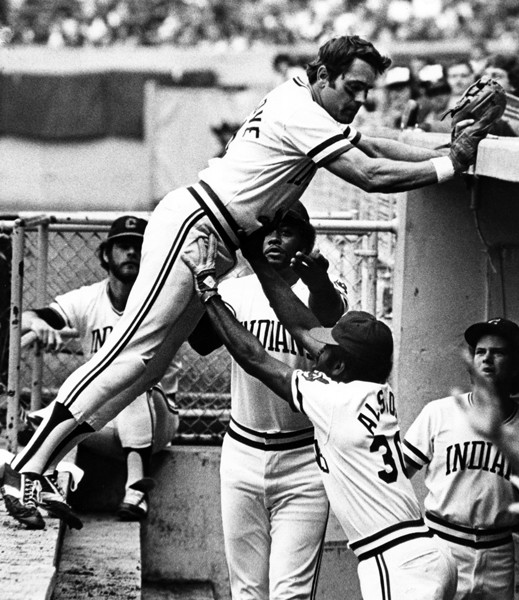 My other takeaway is that perhaps I am not the baseball sage I thought I was.
My other takeaway is that perhaps I am not the baseball sage I thought I was.
***
After chuckling about that day recently, my mind drifted to Cleveland Indians players I’d followed over the years. I began to consider whom might have a) been the most fundamentally sound player (at least in my mind), and b) been someone I thought I knew about, but perhaps didn’t really.
Mike Hargrove? Check, and check. As a manager, there is a ton of available information out there. As a player, not so much. At least, a search for info on Hargrove the player mostly generates results on his managerial career. Interestingly, the popularity of the internet dawned in the mid-1990s, right about the time Hargrove’s career as manager took off. He is known as the skipper of the powerhouse Indians. Hargrove also coined the phrase, “Manny being Manny.”
What are the memories one might have about Mike Hargrove, the player? He is from Texas, and his nickname was The Human Rain Delay, in honor of the glove-tweaking, pants-tugging routine that he followed prior to every pitch. He played first base mostly, but also manned various outfield positions. I also knew, but tried to suppress, that he had to fight his way off the field as a member of the Texas Rangers on Ten Cent Beer Night in Cleveland.
That is pretty much the extent of what I knew about Hargrove as a player. A bit of research reveals that he lettered in baseball and two other sports in college, after not having played baseball in high school. He then spent 2 years in the Rangers’ minor league system, making the jump from AA to the majors in 1974. Hargrove hit .323 and won the American League Rookie of the Year award in ’74.
He was an All-Star in 1975, and led the league in walks in 1976 and 1978. So he had a great batting eye, although I see he did commit a lot of errors at first base.
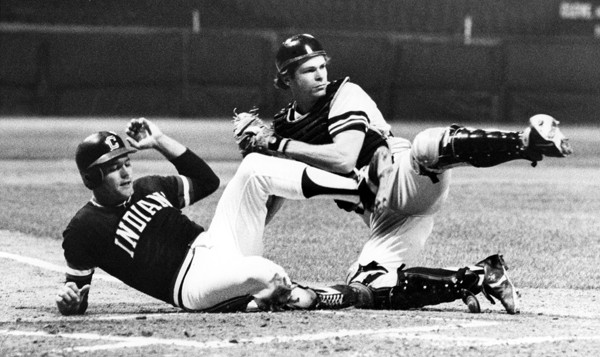 Hargrove was a victim of a money crunch in Texas in 1979, and was dealt to the San Diego Padres. In mid-June, the Indians acquired him for utility player Paul Dade. Between 1979 and 1985, Hargrove’s overall batting average was .290 for the Tribe. He continued to take a lot of pitches, drawing over 100 walks in 4 of those seasons. He never was one to hit for a lot of power, so he was perhaps overshadowed some by the heavy-hitting first basemen in the AL at the time.
Hargrove was a victim of a money crunch in Texas in 1979, and was dealt to the San Diego Padres. In mid-June, the Indians acquired him for utility player Paul Dade. Between 1979 and 1985, Hargrove’s overall batting average was .290 for the Tribe. He continued to take a lot of pitches, drawing over 100 walks in 4 of those seasons. He never was one to hit for a lot of power, so he was perhaps overshadowed some by the heavy-hitting first basemen in the AL at the time.
Let’s take a look at a game in which Mike Hargrove played a key role: 6/29/84. The last-place Indians were 21 ½ games out of first, and it wasn’t even July yet. But that's not to say they didn’t play in some compelling ball games. They could hit, as evidenced by their scoring the third most runs in the league that year.
On this day, Indians ace Bert Blyleven (who would wind up with a 19-7 record that season) faced Mike Hargrove’s former team, the Rangers. Pitching for Texas was Dave Stewart (who in future seasons would become a dominant starter for the champion Oakland A’s).
Neither team scored until the bottom of the 2nd, when Tribe LF Mel Hall and C Jerry Willard each singled. RF George Vukovich drove in Hall with a sacrifice fly to center field. Prior to that point, each pitcher appeared to be in control. Blyleven’s famous curve ball must have been working, as he was inducing a lot of ground balls. It didn’t appear he was able to control it very well, as he’d yielded a walk, a hit-by-pitch, and a wild pitch. He did allow a single to Rangers and former 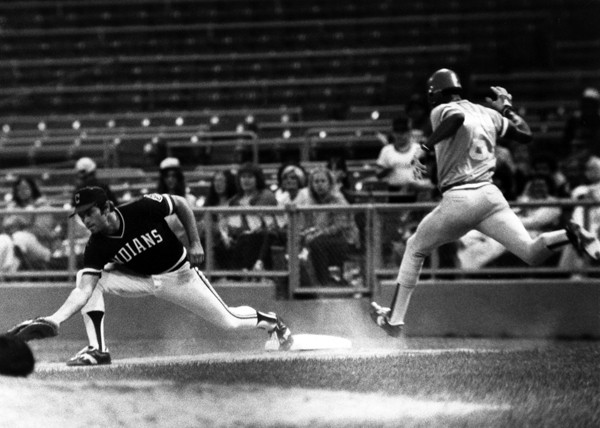 Indians 3B Buddy Bell in the 1st. (This drew an extended ovation that rivaled the one he received when the starting lineups had been announced. They booed Bell plenty when he played for the Tribe, but he was also a favorite of many and was now remembered fondly.) Also of note: in the 1st, Mike Hargrove moved SS Julio Franco from second to third with a ground out to the right side of the infield. (Fundamentals.) After 2, 1-0 Tribe.
Indians 3B Buddy Bell in the 1st. (This drew an extended ovation that rivaled the one he received when the starting lineups had been announced. They booed Bell plenty when he played for the Tribe, but he was also a favorite of many and was now remembered fondly.) Also of note: in the 1st, Mike Hargrove moved SS Julio Franco from second to third with a ground out to the right side of the infield. (Fundamentals.) After 2, 1-0 Tribe.
The Rangers answered in the top of the 4th. Two runs scored on a single by C Donnie Scott (they were unearned on Tribe 2B Tony Bernazard’s second error of the game. He threw the ball away). Middle of 4, 2-1 Rangers.
1984 was one of those real nice seasons for Indians slugger Andre Thornton. He’d end up with 33 homers and 99 RBI. He homered off Stewart in the Tribe 4th. After 4, tied 2-2.
Blyleven came off the rails in the 5th inning. With one out, Bell and 1B Pete O’Brien hit back-to-back home runs. Then RF Lance Parrish, LF Bob Jones and CF Gary Ward went double-single-single to send Blyleven to the showers. Indians reliever Tom Waddell entered the game and issued a single to PH Marv Foley. Willard allowed a passed ball, and then Waddell walked Scott.
Mike Jeffcoat came on to relieve Waddell. He induced a couple of groundouts, with another run scoring. Middle of 5, 8-2 Rangers.
In the home half of the 5th, CF Brett Butler stroked a one-out double. (Butler had a great season in 1984. He stole 54 bases, walked 86 times, and scored 108 runs.) With two out, Hargrove worked a walk. Then it was back-to-back-to-back jacks by Thornton, Hall and Willard. That was it for the pitcher Stewart. A young Tom Henke came in to put out the fire. After 5, 8-7 Rangers.
The Indians came up to bat in the bottom of the 8th, down by three runs. 3B Brook Jacoby led off the inning with a walk, and Butler hit a one-out single. Franco 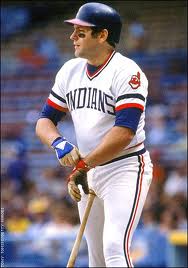 doubled home Jacoby. So now, the Tribe was down by 2 with the leading run at the plate in the 8th.
doubled home Jacoby. So now, the Tribe was down by 2 with the leading run at the plate in the 8th.
Up came Mike Hargrove. Big moment. Click here to prepare for the at-bat. BOOOM. Hargrove didn’t homer often, but he did here. After 8, 11-10 Tribe.
Ernie Camacho came on in the 9th for the Indians, for the save. It didn’t go as planned; the inning was a mess. After striking out the leadoff hitter, Camacho allowed a double, a single, a balk, and an intentional walk. The tying run scored on the single. After 9, tied 11-11.
The game moved to extra innings. In the Rangers 12th, Tribe pitcher Jamie Easterly surrendered the go-ahead run. However, in the bottom of the inning, PH Carmen Castillo singled. Butler hit into a force, and then stole second. Franco walked. 1B Pat Tabler (who’d pinch run for Hargrove in the 10th after an intentional walk) singled. Andre Thornton’s mere presence at the plate led to a game-tying wild pitch. After 12, tied 12-12.
In the home half of the 13th, Willard walked to lead off the inning. Joe Carter pinch ran. (Carter and Mel Hall had just been acquired from the Chicago Cubs about two weeks prior.) Vukovich singled Carter to third, and Jacoby singled him home. Tribe wins!!!! 13-12.
In 1984, the Indians dug themselves such a deep hole early that the season was over by June. But the pickup that month of Hall and Carter contributed to a 53-52 record over the final 105 games.
Mike Hargrove was eventually replaced in the Indians lineup by Pat Tabler. Grover was not re-signed after 1985, and immediately began his coaching/managing career.
Thank you for reading.
Sources included baseball-reference.com, The Cleveland Indians Encyclopedia, Schneider.
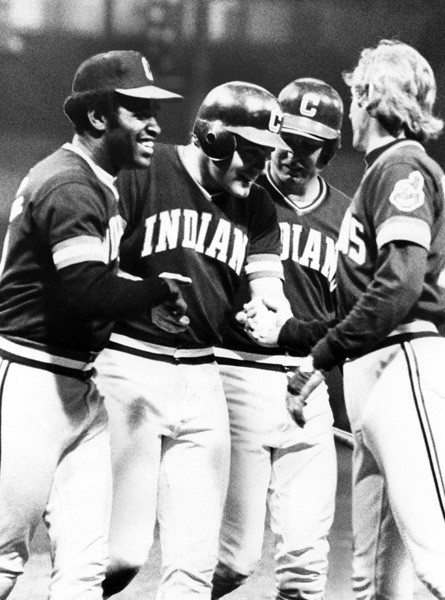
- NBA Announces 2013-2014 Schedule
- Browns Ink Sharknado
- Sharknado A No-Show For Rookie Camp
- Trent Richardson Out Until Training Camp
- Browns Sign Brandon Jackson
- Carrasco Suspended Eight Games
- Browns Add to Wide Receiver Depth with David Nelson
- Browns Need to Learn from Past Draft Mistakes
- Browns Release Chris Gocong and Usama Young
- Browns Missing on Grimes Disappointing, But Not The End
The TCF Forums
- Chris Grant's first 3 drafts
Kingpin74 (Tuesday, January 21 2014 10:13 AM) - The 2014 Offseason Thread
googleeph2 (Tuesday, January 21 2014 9:36 AM) - 2015 Recruiting
furls (Tuesday, January 21 2014 6:57 AM) - Mike Brown
YahooFanChicago (Monday, January 20 2014 11:15 PM) - Movies coming out
HoodooMan (Monday, January 20 2014 9:34 PM) - 2014 Hoops Hockey Hijinx
jpd1224 (Monday, January 20 2014 4:44 PM) - 2014 Recruiting
jclvd_23 (Monday, January 20 2014 2:26 PM) - Wish List - #4 Pick
Hikohadon (Monday, January 20 2014 1:26 PM) - Official- Browns Coach Search/Rumors
OldDawg (Sunday, January 19 2014 6:48 PM) - #1 overall pick Anthony Bennett
TouchEmAllTime (Sunday, January 19 2014 1:28 PM)



